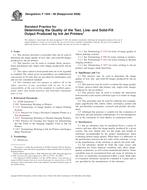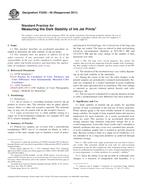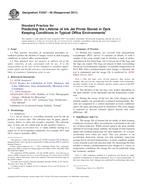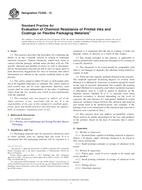We need your consent to use the individual data so that you can see information about your interests, among other things. Click "OK" to give your consent.
ASTM D1316-06(2011)
Standard Test Method for Fineness of Grind of Printing Inks By the NPIRI Grindometer (Withdrawn 2020)
Automatically translated name:
Standard Test Method for Fineness of Grind of Printing Inks By the NPIRI Grindometer
STANDARD published on 1.6.2011
The information about the standard:
Designation standards: ASTM D1316-06(2011)
Note: WITHDRAWN
Publication date standards: 1.6.2011
SKU: NS-16958
The number of pages: 7
Approximate weight : 21 g (0.05 lbs)
Country: American technical standard
Category: Technical standards ASTM
The category - similar standards:
Annotation of standard text ASTM D1316-06(2011) :
Keywords:
A1 Scraper, Automatic Drawdown Machine (ADM-1), degree of dispersion, grind gauge, NPIRI Grindometer, pigment dispersions, printing inks, Dispersion, Fineness of grind (dispersion), Grinding materials/operations, NPIRI grindometer, Pigment dispersion (paints/related coatings/materials), Pigments (general properties), Printing inks/vehicles, ICS Number Code 87.080 (Inks. Printing inks)
Additional information
| Significance and Use | ||||||||||||
|
Oversize particles in a printing ink may damage a printing plate, plug a cell, clog a nozzle and adversely affect the appearance of printed ink films. Fineness of grind measurements are useful for deciding when to stop the dispersion process and for determining if the test material meets specifications as agreed upon between the supplier and the customer. |
||||||||||||
| 1. Scope | ||||||||||||
|
1.1 This test method describes the procedure for determining the fineness of grind of printing inks using a NPIRI Grindometer. It evaluates the size of the largest particles in a finished dispersion but not average particle size or concentration of sizes. 1.2 This test method covers both manual and automatic drawdowns using an A1 scraper. 1.3 This test method is applicable to any dispersion that is fine enough to fall within the 0–25 μm range of the specified grind gauge. With a minor variation in procedure, it is applicable to both paste (nonvolatile) and liquid (volatile) inks. Note 1—The 0–25 μm gauge specified in this test method is similar in principle to the 0–100 μm Hegman gauge described in Test Method D1210 and the various gauges described in ISO 1524:2000. Sieve analysis for concentration of particles above 45 μm is covered in Test Method D2067. 1.4 This standard does not purport to address all of the safety concerns, if any, associated with its use. It is the responsibility of the user of this standard to establish appropriate safety and health practices and determine the applicability of regulatory limitations prior to use. |
||||||||||||
| 2. Referenced Documents | ||||||||||||
|
Similar standards:
Historical
1.7.2008
Historical
1.10.2011
Historical
1.10.2010
Historical
1.10.2011
Historical
1.10.2011
Historical
1.5.2013
We recommend:
Technical standards updating
Do you want to make sure you use only the valid technical standards?
We can offer you a solution which will provide you a monthly overview concerning the updating of standards which you use.
Would you like to know more? Look at this page.



 ASTM F1944-98(2008)..
ASTM F1944-98(2008).. ASTM F1945-05(2011)..
ASTM F1945-05(2011).. ASTM F1946/F1946M-10..
ASTM F1946/F1946M-10.. ASTM F2035-00(2011)..
ASTM F2035-00(2011).. ASTM F2037-00(2011)..
ASTM F2037-00(2011).. ASTM F2250-13
ASTM F2250-13
 Cookies
Cookies
